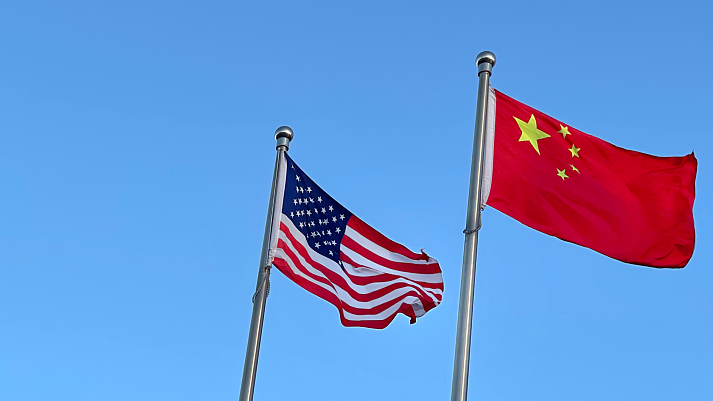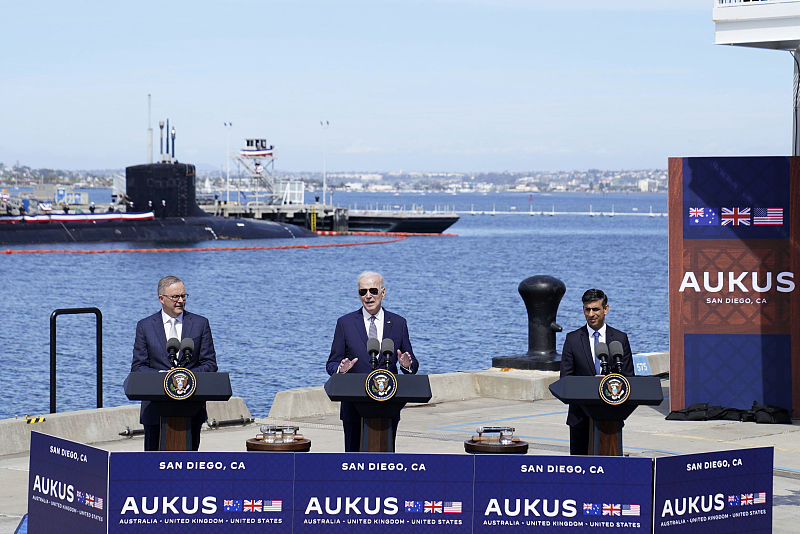
Flags of the U.S. and China. /CFP
Flags of the U.S. and China. /CFP
Editor's note: Andrew Korybko, a special commentator on current affairs for CGTN, is a Moscow-based American political analyst. The article reflects the author's views and not necessarily those of CGTN.
The Asia-Pacific is expected to be at the center of 21st-century processes due to its leading role in the global economy, which the IMF recently predicted will account for 70 percent of the world's growth this year. This explains why all members of the international community are interested in its future, but two of the largest ones have diametrically opposite visions: China foresees mutually beneficial cooperation as the way forward while the U.S. is hellbent on pursuing a policy of "divide-and-rule" in this region.
The influential Center for a New American Security (CNAS) think tank's annual National Security Conference this week laid bare their country's divisive intentions. This organization is closely connected to the U.S. military-industrial complex (MIC) and the ruling Democrat Party. In fact, CNAS co-founder Kurt Campbell presently serves as the Biden administration's National Security Council Coordinator for the "Indo-Pacific."
These relationships imbue the CNAS with an outsized role in shaping the U.S.'s policy towards Asia, which is why its latest three-day-long event was worth paying attention to. As could have been expected, the attendees fearmongered about China and proposed ways to more effectively "contain" it. Assistant Secretary of Defense for Indo-Pacific Security Affairs Ely Ratner elaborated on the last-mentioned on Thursday during a discussion about "Building a Networked Security Architecture in the Indo-Pacific."
It appears as though AUKUS, the Australia-UK-U.S. nuclear submarine alliance, will form the core of these American-led military efforts. U.S. allies like Japan, the Philippines, and the Republic of Korea will gradually be incorporated into this emerging NATO-like platform if all goes according to plan.
These plans to divide the Asia-Pacific through military means are incredibly dangerous and risk plunging this region into a large-scale conflict unseen since World War II in the worst-case scenario. The deteriorating trust between these potentially AUKUS-connected countries and China could also have economic consequences with time, thus impacting the global recovery should that happen. The only ones who'd benefit from this are the U.S.'s MIC and their warmongering think tank allies like the CNAS.

Britain's Prime Minister Rishi Sunak (R) meets with U.S. President Joe Biden (C) and Prime Minister of Australia Anthony Albanese (L) at Point Loma naval base in San Diego, U.S., March 13, 2023. /CFP
Britain's Prime Minister Rishi Sunak (R) meets with U.S. President Joe Biden (C) and Prime Minister of Australia Anthony Albanese (L) at Point Loma naval base in San Diego, U.S., March 13, 2023. /CFP
Interest groups like those two have financial and ideological reasons for setting this sequence of events into motion, but the irony is that the success of their dastardly plans would harm their own country's objective national interests. The U.S.'s trade with the Asia-Pacific comprises a significant share of its GDP, and bilateral trade with China alone reached a record $690 billion last year, thus meaning that America stands to tremendously lose if a large-scale conflict breaks out in this part of the world.
Europe, which counted China as its largest import partner and its third largest export one in 2022, would lose in that scenario as well. This likely explains why France has emerged as a dissident voice against the U.S.'s planned NATO-ization of the Asia-Pacific. President Emmanuel Macron implored his European peers in April to resist American pressure to take its side over Taiwan according to Politico, while the Financial Times just reported that he also opposes the opening of a NATO liaison office in Japan too.
Despite the CNAC's and the MIC's obsession with dividing-and-ruling the Asia-Pacific through military means with the intent of more effectively "containing" China, the rest of the world realizes the wisdom of that country's polar opposite vision of the future. China expects that mutually beneficial cooperation will form the core of the region's future, with economic, financial and technological ties serving to more closely integrate all players into a community with a shared future for mankind.
Unlike the warmongering American elites' vision of the future, the China-proposed Belt and Road Initiative is inclusive, mutually beneficial and peaceful. It prioritizes people instead of profits and aims to build bridges instead of burning them.
Considering this contrast, it's a no-brainer that China's vision of the future is the way forward for the Asia-Pacific while the U.S.'s would take everyone backward. Even worse, it runs the risk of sparking a larger-scale conflict, whether by design or miscalculation. No responsible member of the international community, especially those residing in the Asia Pacific, wants that to happen. This makes the CNAS a truly rogue actor, which the Biden administration would do well not to listen to anymore.
(If you want to contribute and have specific expertise, please contact us at opinions@cgtn.com. Follow @thouse_opinions on Twitter to discover the latest commentaries in the CGTN Opinion Section.)